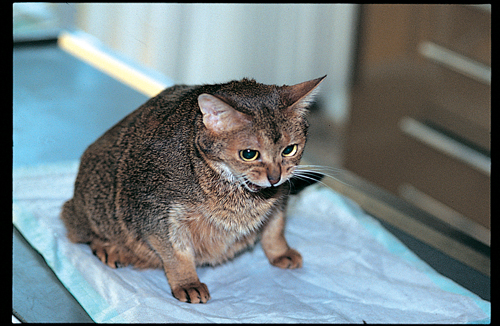Small Animal Emergency and Critical Care Medicine Q&A 08
| This question was provided by Manson Publishing as part of the OVAL Project. See more Small Animal Emergency and Critical Care Medicine Q&A. |
A six-year-old Somali cat was presented with a history of polyuria, polydipsia, weight loss, vomiting and lethargy. The cat had not been eating well for the past 3 days. Physical examination found the cat approximately 8% dehydrated and mentally depressed. There was evidence of weight loss. Thoracic and abdominal examination was unremarkable. The retinas were normal.
Initial laboratory data: PCV – 55%; TS – 8.5 g/dl; BUN labstick – 50–80 mg/dl; glucose by labstick – 460 mg/dl (25,8 mmol/l); Na+ – 165 mEq/l; K+ – 2.6 mEq/l; venous pH – 7.2; PCO2 – 40 mmHg; HCO3 – 8 mEq/l. Urinanalysis: SG – 1.026 with 4+ glucose, 2+ ketones, 1+ protein, 5 WBCs/hpf and intracellular cocci. Initial BP by indirect methods was 120/80 mmHg (16/10.6 kPa).
| Question | Answer | Article | |
| What is your working diagnosis and problems list? | Diabetes mellitus with ketoacidosis. Problems include history of polyuria/polydipsia, anorexia and weight loss, azotemia, cystitis, dehydration, ketonuria, hyperglycemia. |
Link to Article | |
| Describe your initial treatment plan for this cat. |
|
Link to Article | |
| What other electrolytes must you evaluate, and why? | Serum phosphorus, magnesium and potassium are critical electrolytes. Hypophosphatemia is often evident on day 2 or 3 of hospitalization and can be associated with intravascular hemolysis and weakness. Hypokalemia should be anticipated once insulin therapy is initiated, and potassium must be supplemented. |
Link to Article | |
| What are potential complications? | Complications include severe acidosis, arrhythmias, altered mentation, acute renal failure, hypernatremia, dehydration, hypophosphatemia, hypoglycemia from therapy, hypokalemia, thromboemboli and infections. |
Link to Article | |
| Would you use sodium bicarbonate? Why or why not? | Rehydration and reperfusion should be the initial mainstay of the acid–base therapy. Overzealous bicarbonate therapy can lead to alkaline overshoot, hypokalemia, hypocalcemia, paradoxical CSF acidosis, hypernatremia and hyperosmolality, and shift of the oxyhemoglobin dissociation curve. |
Link to Article | |
| You are treating the cat and have brought the glucose to within normal range. However, there is now 4+ ketonuria. Explain the increase in ketones on the urine dipstick. | As the glucose is lowered, the ketones become metabolized. Beta-hydroxybutyric acid is not detected on the urine dipstick. There could have been a high concentration of this metabolite initially. It is then metabolized to acetoacetic acid and acetic acid, which are detected by the urine test strip. Therefore, it appears as though there is an increase in ketones. |
Link to Article | |
